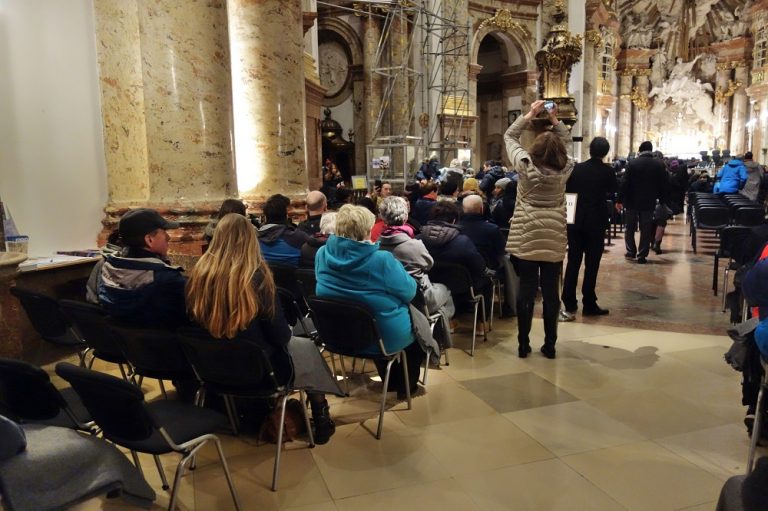

Red Tram Hours: 4am-Midnight, every 5-10 minutes. Tram #D splits to run along the Southside of Belvedere Palace for easy access to see the grounds and goes all the way to Vienna’s Main Train Station. As they exit the Ring Road in the East, Tram #71 runs along the Northside of Belvedere Palace all the way to both Mozart’s and Beethoven’s Graves ( see our map). This stretch is where most of the sights are making these two trams a good addition to your tram tour mix. In the East, Tram #1 splits off with access to the Hundertwasserhaus and Prater Amusement Park while Tram #2 splits off to the North to Augarten Park with its famous Flak Towers.Īnother helpful set of Red Trams are #71 and #D ( purple on our map) which run up the Western and Southern side of Vienna’s Ring Road along the same tracks as #1 & #2. Each line goes a couple of miles out of the way where they split from the loop so you have to pay attention when it’s time to switch lines.
#Karlskirche vienna opening hours wednesday full#
While the Tram #1 and #2 lines overlap for part of the Ringstrasse you will have to switch lines halfway through to complete the full loop. The best thing about the Red Tram option is that you can use the standard city tram pass good on all normal lines and do not need to buy a special pass like you would with the Yellow Line option.

This is a nice option as it allows you to catch Red Trams in both directions around the Ringstraße loop all day which come about every 5-10 minutes. Hope you enjoy our Ringstrasse tram tour in Vienna!Ībout The Red Trams: If you want the most sightseeing flexibility, we suggest doing a tram combination of the Red Line #1 ( blue on our map) and Red Line #2 ( red on our map). We have also included tips to help you utilize the public transportation options ( tram & subway) listed below to help save your feet as some of the sights are spread out. Consider it a very easy hop-on, hop-off walking tour around the Ringstrasse that you get to do at your own pace. To help you get the most out of your visit, we have put together a helpful do-it-yourself Vienna Ring Tram Tour so you can visit all of the best sights. Today the spacious Ringstrasse is as delightful as ever with world-class museums, inviting beer gardens, grand cathedrals, and impressive architecture on every block. You can imagine how the grand Ringstrasse became the place to see and be seen. By 1900, Vienna had grown to 2.5 million people and the 5th largest city in the World at the time. During the massive project, the Ringstrasse ( pronounced Ring-Strassa) quickly became lined with some of Europe’s most impressive buildings and gave the needed space for Vienna’s population to explode. With the urging of controversial Mayor Karl Lueger, Emperor Franz Joseph had the Medieval wall tore down and the dry moat filled into to create a grand boulevard to help modernize the expanding city. Vienna kept prospering over the centuries, and by 1860 the then 500,000-person town needed to grow outward again. This protection helped Vienna fight off the Turkish Sieges of 1529 & 1638 which may have saved the rest of Europe from being overtaken. This new wall was very heavily fortified with watchtowers & bastions, was surrounded by a moat, and ringed with a wide building-free meadow ( glacis) separating the city from the suburbs. The Medieval wall was completed in 1257 as an expansion outward to accommodate the flourishing trade town. The acoustics are fantastic.The 3.2-mile-long Ringstrasse ( Ring Road) looping around Old Town Vienna traces the path of the impressive Medieval wall that once protected the city. During Advent, atmospheric gospel singing fills the sacred building. A tip for fans of classical music: Church concerts – for example, Mozart's Requiem or Vivaldi's Four Seasons, are performed in the Karlskirche (Church of St. The fountain, which is filled in summer and offers a breathtaking reflection of the church, is a popular social meeting point. The small but mighty Museo Borromeo, also called the treasury, shows sacred exhibition pieces, such as the historic traveling clothes of the namesake.Įvents such as the Popfest, the Art Advent Market and many other public open-air events are regularly held in front of the Karlskirche (Church of St. From there they have a fantastic view of Karlsplatz, Resselpark, the Musikverein, and the Technical University of Vienna. Via the organ gallery, visitors reach the outside terrace directly above the entrance portal. In the vestibule is a 2,47 meter-tall model of the church, which faithfully presents the details of both the interior and the imposing façade. Inside, the marble look dominates with red and gold accents, the sumptuously decorated high altar is also by the architect Fischer von Erlach.


 0 kommentar(er)
0 kommentar(er)
